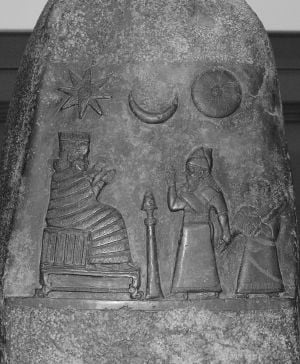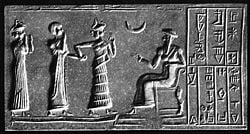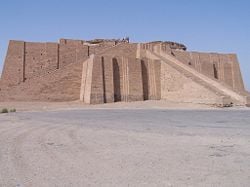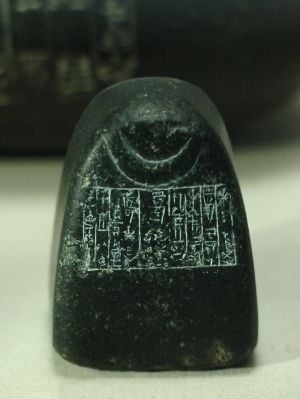Difference between revisions of "Sin (mythology)" - New World Encyclopedia
m (→Worship) |
m (→Worship) |
||
| Line 28: | Line 28: | ||
[[Image:Weight Shulgi Louvre AO22187.jpg|thumb|Measuring weight with the symbol of Nanna used by his priests at Ur and dedicated by King Shulgi in the twenty-first century B.C.E.]] | [[Image:Weight Shulgi Louvre AO22187.jpg|thumb|Measuring weight with the symbol of Nanna used by his priests at Ur and dedicated by King Shulgi in the twenty-first century B.C.E.]] | ||
| − | |||
One of Nanna/Sin's most famous worshipers was [[Enheduanna]], his high priestess who lived in the twenty-third century B.C.E. and is known today as the first named author in history, as well as the first to writer in the first person. The daughter of King [[Sargon I]], her writings invoke [[Inanna]]'s aid as Sin's daughter far more than they dare to speak of to the god directly. | One of Nanna/Sin's most famous worshipers was [[Enheduanna]], his high priestess who lived in the twenty-third century B.C.E. and is known today as the first named author in history, as well as the first to writer in the first person. The daughter of King [[Sargon I]], her writings invoke [[Inanna]]'s aid as Sin's daughter far more than they dare to speak of to the god directly. | ||
| Line 36: | Line 35: | ||
The ziggurat only part of the temple complex, which was Nanna's dwelling place the patron deity of Ur. The ziggurat served to bridge the distance between the sky and the earth and it—or another like it—served as the basis for the famous story of the [[Tower of Babel]] in the Bible. It later fell into desrepair but was stored the Assyrnian King [[Shalmaneser]] in the ninth century B.C.E., and once again by [[Asshurbanipal]]. | The ziggurat only part of the temple complex, which was Nanna's dwelling place the patron deity of Ur. The ziggurat served to bridge the distance between the sky and the earth and it—or another like it—served as the basis for the famous story of the [[Tower of Babel]] in the Bible. It later fell into desrepair but was stored the Assyrnian King [[Shalmaneser]] in the ninth century B.C.E., and once again by [[Asshurbanipal]]. | ||
| − | About 550 B.C.E., Nabonidus the last of the neo-Babylonian, showed particular devotion to the Moon god. His mother had been the high priestess of Sin at [[Harran]], and he placed his daughter in the same position at Ur. Some scholars believe that Nabonidus promoted Sîn as the national god of Babylon superior even to [[Marduk]]. In any case, Nabodinus support for the temples of Sin seems to have alienated the priests at the capital of Babylon, who were devoted to Marduk and consequently denigrated Nabonidus for his lack of attention to | + | About 550 B.C.E., [[Nabonidus]], the last of the neo-Babylonian, showed particular devotion to the Moon god. His mother had been the high priestess of Sin at [[Harran]], and he placed his daughter in the same position at Ur. Some scholars believe that Nabonidus promoted Sîn as the national god of Babylon superior even to [[Marduk]], siting, for example, the following inscription: |
| + | |||
| + | <blockquote>O Sin, king of the gods of heaven and the netherworld, without whom no city or country can be founded, nor be restored, when you enter (your temple) Ehulhul, the dwelling of your plenitude, may good recommendations for that city and that temple be set on your lips. May the gods who dwell in heaven and the netherworld constantly praise the temple of Sin, the father, their creator. As for me, Nabonidus king of Babylon, who completed that temple, may Sin, the king of the gods of heaven and the netherworld, joyfully cast his favorable look upon me and every month, in rising and setting, make my ominous signs favorable.</blockquote> | ||
| + | |||
| + | In any case, Nabodinus support for the temples of Sin seems to have alienated the priests at the capital of Babylon, who were devoted to [[Marduk]] and consequently denigrated Nabonidus for his lack of attention to his religious duties there. They consequently welcomed [[Cyrus the Great]] of Persia when he overthrew Nabonidus. | ||
| − | After this, Sin continued play a | + | After this, Sin continued play a role in Mesopotamian religion, but a waning one. Christian scholars have sometimes seen a connection between Sin and Allah, noting that before his conversion to Islam, Muhammad himself worshiped several deities including the moon, and the Islam adopted Nanna's crescent as its symbol. |
==See also== | ==See also== | ||
Revision as of 06:21, 27 December 2008
Nanna, also called Sin (also Suen) was a Sumerian god who played a longstanding role in Mesopotamian religion and mythology. He was the god of the moon, the son of the sky god Enlil and and the earth goddess Ninlil. His sacred city was Ur. The name Nanna is Sumerian for "illuminator." In Akkadian and later Babylonian mythology he is usually called Sin.
Known as Nanna in Sumer, he was named Sin in Babylonia and Assyria, and was also worshiped in Harran. In his anthropomorphized form, Sin had a beard made of lapis lazuli and rode on a winged bull. His wife was Ningal ("Great Lady"), who bore him Utu ("Sun") and Inanna (the Sumerian name for Ishtar). In art, his symbols are the crescent moon, the bull (through his father, Enlil, "Bull of Heaven"), and the tripod.
Mythology
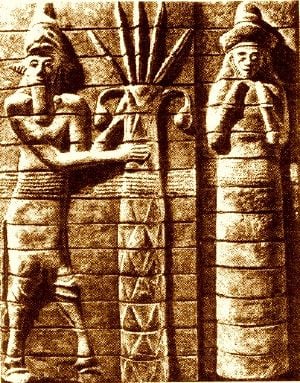
In Mesopotamian mythology, Nanna was the son of the sky god Enlil and and the grain goddess Ninlil. His best-known offspring were the sun god Shamash and the great goddess of love and war, Inanna, better known today as Ishtar.
Nanna's origin myth is a touching story of his father's passion and his mother's sacrificial love. The virgin Ninlil bathes in the sacred river, where she seen by the bight eye of Enlil, who falls in loves with her and seduces (or rapes) her. The assembly of the gods then banishes Enlil to the underworld for his transgression. Ninlil, knowing she is pregnant with the "bight seed of Suen," follows Enlil to the world of the dead, determined that "My master's seed can go up to the heavens!" Once the moon god is born, three additional children are offered so that Nanna/Suen may take his places in the skies to light up the night.
The moon played a key role in Mesopotamian religious culture. As it moved through its phases, people learned to keep their calendars based on the lunar month. Nanna (or Suen/Sin) was sometimes pictured as riding his crescent moon-boat, as it made its monthly journey through the skies. Some sources indicate that the moon god was called by different names according to various phases of the moon. The name Sin thus came to be associated with crescent moon, with the older Sumerian name Nanna was sometimes connected to the full Moon.
People speculated that perhaps the moon-disk was Sin's crown, and thus one of his titles was "Lord of the Diadem." As the mysterious deity of the night, he was also called "He whose deep heart no god can penetrate." His chief attribute, however, was wisdom, which he dispensed not only to humans through his priests, but also to the gods themselves who came to consult him every month.
Sin's status was very formidable, not only in terms of the temples dedicated to him, but also in terms of astrology, which became a prominent feature of later Mesopotamian religion, and even legal matters. For an entire millennium—from 1900 to 900 B.C.E.—Sin's name is invoked as a witness to international treaties and covenants made by the Babylonian kings. His attribute of wisdom was particularly expressed in the science of astrology, in which the observation of the moon's phases was an important a factor. The centralizing tendency in Mesopotamian religion led to his incorporation in the divine triad consisting of Sin, Shamash, and Ishtar, respectively personifying the moon, the sun, and the planet Venus. In this trinity, the moon held the central position. However, it is likely that Ishtar, even though she was Sin's daughter, came to play the more important cultural role as time went on, as she rose to the key position in among the Mesopotamian goddess, while younger deities like Marduk came to predominate on the male side of the pantheon.
Worship
The two chief seats of Sin's worship were Ur in the south, and Harran to the north. The so-called "giparu" (Sumerian: Gig-Par-Ku) at Ur where the Nanna's priestesses resided was a major complex with multiple courtyards, a number of sanctuaries, burial chambers for dead priestesses, a ceremonial banquet hall, and other structures. From about 2600-2400 B.C.E.), when the Ur was the leading city of the Euphrates valley, Sin seems to have held the position of the head of the pantheon. It was during this period that he inherited such titles as "Father of the Gods," "Chief of the Gods," and "Creator of All Things," which were assigned to other deities in other periods.
The cult of Sin spread to other centers, and temples of the moon-god have been found in all the large cities of Babylonia and Assyria. Sin's chief sanctuary at Ur was named E-gish-shir-gal ("house of the great light"). His sanctuary at Harran was named E-khul-khul ("house of joys"). Inanna/Ishtar sometimes played a key role in these temples as well.
On cylinder seals, Sin is represented as an old man with a flowing beard with the crescent as his symbol. In the later astral-theological system he is represented by the number 30 and the moon, often in crescent form. This number probably refers to the average number of days in a lunar month, as measured between successive new moons. Writings referring to him often refer to him as En-zu, meaning "Lord of wisdom."
One of Nanna/Sin's most famous worshipers was Enheduanna, his high priestess who lived in the twenty-third century B.C.E. and is known today as the first named author in history, as well as the first to writer in the first person. The daughter of King Sargon I, her writings invoke Inanna's aid as Sin's daughter far more than they dare to speak of to the god directly.
The great ziggurate of Ur was dedicated to Nanna and Inanna in the Sumerian city of Ur (in present-day Iraq) in the twentyifirst century B.C.E. A huge stepped platform, in Sumerian times it was called Etemennigur. Today, after more than 4000 years, the ziggurat is still well preserved in large parts, and partially reconstructed. Its upper stage is over 100 feet (30 m) high and the base is 210 feet (64 m) by 150 feet (46 m).
The ziggurat only part of the temple complex, which was Nanna's dwelling place the patron deity of Ur. The ziggurat served to bridge the distance between the sky and the earth and it—or another like it—served as the basis for the famous story of the Tower of Babel in the Bible. It later fell into desrepair but was stored the Assyrnian King Shalmaneser in the ninth century B.C.E., and once again by Asshurbanipal.
About 550 B.C.E., Nabonidus, the last of the neo-Babylonian, showed particular devotion to the Moon god. His mother had been the high priestess of Sin at Harran, and he placed his daughter in the same position at Ur. Some scholars believe that Nabonidus promoted Sîn as the national god of Babylon superior even to Marduk, siting, for example, the following inscription:
O Sin, king of the gods of heaven and the netherworld, without whom no city or country can be founded, nor be restored, when you enter (your temple) Ehulhul, the dwelling of your plenitude, may good recommendations for that city and that temple be set on your lips. May the gods who dwell in heaven and the netherworld constantly praise the temple of Sin, the father, their creator. As for me, Nabonidus king of Babylon, who completed that temple, may Sin, the king of the gods of heaven and the netherworld, joyfully cast his favorable look upon me and every month, in rising and setting, make my ominous signs favorable.
In any case, Nabodinus support for the temples of Sin seems to have alienated the priests at the capital of Babylon, who were devoted to Marduk and consequently denigrated Nabonidus for his lack of attention to his religious duties there. They consequently welcomed Cyrus the Great of Persia when he overthrew Nabonidus.
After this, Sin continued play a role in Mesopotamian religion, but a waning one. Christian scholars have sometimes seen a connection between Sin and Allah, noting that before his conversion to Islam, Muhammad himself worshiped several deities including the moon, and the Islam adopted Nanna's crescent as its symbol.
See also
- Religion of the Ancient Near East
- Ancient Semitic religion
- Great Ziggurat of Ur
ReferencesISBN links support NWE through referral fees
- This article incorporates text from the Encyclopædia Britannica Eleventh Edition, a publication now in the public domain.
- Tamara M. Green, The City of the Moon God: Religious Traditions of Harran. E.J. Brill, Leiden, 1992, 232 pages. ISBN 9004095136
Credits
New World Encyclopedia writers and editors rewrote and completed the Wikipedia article in accordance with New World Encyclopedia standards. This article abides by terms of the Creative Commons CC-by-sa 3.0 License (CC-by-sa), which may be used and disseminated with proper attribution. Credit is due under the terms of this license that can reference both the New World Encyclopedia contributors and the selfless volunteer contributors of the Wikimedia Foundation. To cite this article click here for a list of acceptable citing formats.The history of earlier contributions by wikipedians is accessible to researchers here:
The history of this article since it was imported to New World Encyclopedia:
Note: Some restrictions may apply to use of individual images which are separately licensed.
